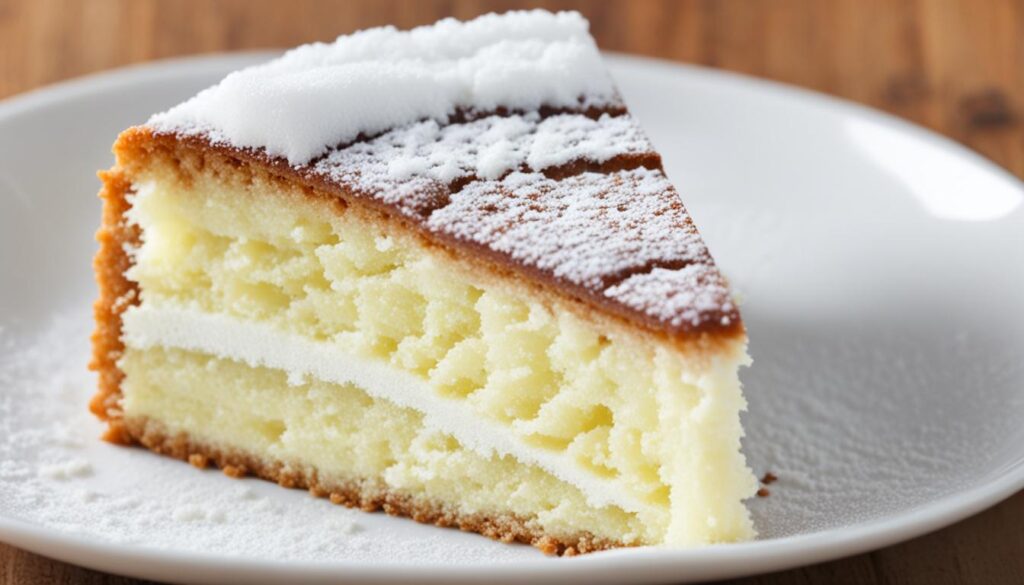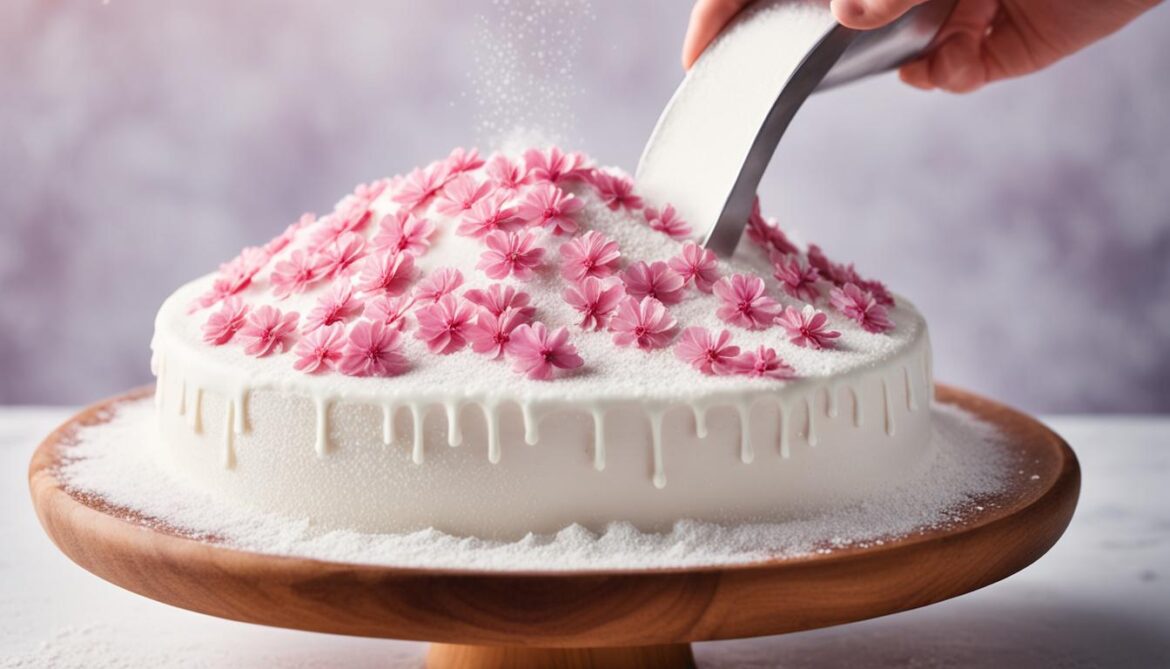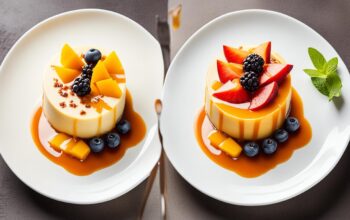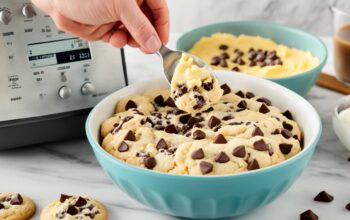Icing sugar, also known as confectioners’ sugar or powdered sugar, is a versatile ingredient that can be used in a variety of sweet treats. From frosting to delicate confections, icing sugar adds sweetness, texture, and decorative flair to baked goods. If you’re a baking enthusiast or simply enjoy indulging in delicious desserts, it’s worth exploring the many uses and tips for baking with icing sugar.
Key Takeaways:
- Icing sugar is a versatile ingredient that adds sweetness, texture, and decorative flair to baked goods.
- It can be used in frosting, confections, candy making, and as a decorative dusting.
- Using powdered sugar glaze is an easy way to create a smooth and sweet topping for cakes and cookies.
- Try using icing sugar in traditional recipes like snowball cookies for an extra layer of sweetness.
- Experiment with different techniques for dusting powdered sugar to elevate the presentation of your desserts.
Introduction to the Sweet World of Powdered Sugar
Powdered sugar, also known as confectioners’ sugar or icing sugar, is a finely ground sugar that is used in a variety of baking and dessert recipes. This sweet substance dissolves easily and adds sweetness and texture to sweet creations. In this section, we will explore the basics of powdered sugar, including what it is and how it is made, and its role in baking.
Derived from regular granulated sugar, powdered sugar undergoes a unique process to achieve its fine texture. The sugar is ground into a fine powder and then mixed with a small amount of cornstarch to prevent clumping. This combination creates a smooth, powdery consistency that is perfect for icing, frosting, and dusting desserts.
Powdered sugar is commonly used in recipes that require a smooth and lump-free texture. Its ability to dissolve quickly makes it ideal for creating silky icings and glazes. Additionally, it effortlessly blends with other ingredients, resulting in a uniform and smooth mixture.
One of the key advantages of using powdered sugar in baking is its ability to enhance the sweetness of desserts without altering their texture. This is particularly important when preparing delicate pastries and intricate decorations, where using regular granulated sugar may cause a grainy texture.
The Role of Powdered Sugar in Baking
When incorporated into baking recipes, powdered sugar performs various functions:
- Enhances sweetness: Powdered sugar adds a delightful sweetness to cakes, cookies, and other baked goods.
- Improves texture: Its fine consistency helps to create light and tender desserts.
- Stabilizes icings and frostings: The cornstarch present in powdered sugar helps thicken and stabilize icings, preventing them from becoming runny.
- Aids in dusting: Powdered sugar can be dusted over finished desserts for an attractive appearance and a touch of sweetness.
Now that we have explored the basics of powdered sugar, let’s delve deeper into its vast array of uses in baking and cooking. In the next section, we will explore the many ways you can incorporate this versatile ingredient into your sweet creations.
The Many Uses of Powdered Sugar in Baking and Cooking
Powdered sugar, also known as confectioners’ sugar or icing sugar, is a versatile and essential ingredient in baking and cooking. Its fine texture and ability to dissolve quickly make it ideal for a wide range of applications. Let’s explore some of the key uses of powdered sugar:
Dusting Baked Goods
One of the most common uses of powdered sugar is for dusting baked goods. Whether it’s a freshly baked cake, cookies, or pastries, a light dusting of powdered sugar adds a touch of sweetness and elegance. The fine particles of the sugar create a beautiful and delicate coating that enhances the visual appeal of the treats.
Creating Icings and Frostings
Powdered sugar is a key ingredient in making delicious icings and frostings. The fine texture of the sugar allows it to dissolve easily when mixed with other ingredients, resulting in smooth and creamy textures. From classic buttercream to rich cream cheese frosting, powdered sugar adds sweetness and helps achieve the perfect consistency for spreading or piping.
Making Candy and Sweets
Powdered sugar is also commonly used in making a variety of candies and sweets. From fudge to marshmallows, powdered sugar plays a crucial role in creating a smooth and melt-in-your-mouth texture. It helps bind the ingredients together and provides the desired sweetness. Additionally, powdered sugar is often used to coat candies and truffles, adding a sweet and polished finish.
Decorating Cakes and Pastries
Powdered sugar is a versatile tool for decorating cakes and pastries. It can be used in various ways to create stunning designs and patterns. For example, by using stencils, you can sprinkle powdered sugar over a cake to form intricate shapes or letters. Dusting powdered sugar on top of pastries can also highlight their textures and add an artistic touch.
Enhancing Flavors in Baking
In addition to its visual appeal, powdered sugar enhances the flavors of baked goods. The sweetness it provides balances the flavors of other ingredients, bringing out their best qualities. It also helps to retain moisture in baked goods, resulting in a soft and tender texture. Whether you’re making cookies, cakes, or muffins, powdered sugar is a valuable ingredient for achieving optimal taste and texture.
These are just a few examples of the many uses of powdered sugar in baking and cooking. Its versatility and ability to enhance flavors and aesthetics make it an indispensable ingredient for any baker or cook. Now that we’ve explored the various uses, let’s move on to the next section to discover the art of dusting powdered sugar and adding a touch of elegance to desserts.
The Art of Dusting: How to Use Powdered Sugar to Add a Touch of Elegance to Your Desserts
Dusting powdered sugar on desserts is a simple yet effective way to add a touch of elegance and visual appeal to your sweet creations. Whether you’re decorating a cake or garnishing pastries, powdered sugar can transform the appearance of desserts, giving them a beautiful and delicate finish.
Here are some techniques for dusting powdered sugar and elevating the presentation of your desserts:
1. Light Dusting
For a subtle and elegant touch, lightly sift powdered sugar over the top of your desserts using a fine-mesh sieve. This creates a soft, snowy effect and adds a touch of sweetness to your creations.
2. Stenciled Designs
To create intricate designs on your desserts, use stencils and powdered sugar. Place the stencil on top of your dessert and carefully sift powdered sugar over it. Remove the stencil to reveal a beautiful pattern or design.
3. Dusting with Templates
Create your own templates by cutting out shapes from paper or cardboard. Place the template on top of your dessert and sprinkle powdered sugar using a spoon or a mesh shaker. Experiment with different shapes and sizes to add a personalized touch to your desserts.

4. Using Lace Doilies
Lace doilies can be used as stencils to create intricate patterns on your desserts. Place a lace doily on top of your dessert and sift powdered sugar over it. Carefully remove the doily to reveal a beautiful lace-like design.
5. Sprinkle with Finesse
For a playful and artistic touch, use a spoon or your fingers to sprinkle powdered sugar over your desserts. This technique gives your desserts a whimsical and dynamic look, perfect for casual gatherings or creative presentations.
Remember, the key is to start with a light dusting of powdered sugar and add more as needed. You can always add more, but it’s challenging to remove excess powdered sugar once it’s applied.
| Technique | Effect |
|---|---|
| Light Dusting | Creates a subtle and elegant snowy effect |
| Stenciled Designs | Adds intricate patterns or designs |
| Dusting with Templates | Allows for customized shapes and sizes |
| Using Lace Doilies | Produces beautiful lace-like designs |
| Sprinkle with Finesse | Gives desserts a playful and artistic touch |
Snowball Cookies: A Delightful Confection Rolled in Powdered Sugar
Snowball cookies, also known as Mexican wedding cookies or Russian tea cakes, are a beloved dessert that brings joy to any occasion. These buttery shortbread cookies are filled with pecans, giving them a delightful nutty flavor. But what truly sets snowball cookies apart is their signature powdered sugar coating, which adds an extra layer of sweetness and a whimsical touch.
To make these delectable treats, you’ll need a few simple ingredients:
- 1 cup unsalted butter, softened
- 1/2 cup powdered sugar, plus more for rolling
- 2 cups all-purpose flour
- 1 cup finely chopped pecans
- 1 teaspoon vanilla extract
Here’s how to bake the perfect batch of snowball cookies:
- In a large bowl, cream together the softened butter and powdered sugar until light and fluffy.
- Add the flour, chopped pecans, and vanilla extract to the bowl. Mix until the dough comes together.
- Shape the dough into small balls, about 1 inch in diameter.
- Place the dough balls on a baking sheet lined with parchment paper, leaving some space between each cookie.
- Bake the cookies in a preheated oven at 325°F (160°C) for about 15-18 minutes, or until the edges are golden brown.
- Remove the cookies from the oven and let them cool for a few minutes.
- While the cookies are still warm, gently roll them in powdered sugar until fully coated.
- Transfer the snowball cookies to a wire rack to cool completely.
Once your snowball cookies have cooled, they’re ready to be enjoyed. These bite-sized treats are a delightful addition to any dessert table, offering a buttery and nutty flavor with a satisfying crumbly texture. The powdered sugar coating not only adds a touch of sweetness but also creates a beautiful snowy appearance.
| Ingredients | Quantity |
|---|---|
| Unsalted butter, softened | 1 cup |
| Powdered sugar, plus more for rolling | 1/2 cup |
| All-purpose flour | 2 cups |
| Finely chopped pecans | 1 cup |
| Vanilla extract | 1 teaspoon |
Baking snowball cookies is a delightful experience that fills your home with the warm, comforting aroma of butter and pecans. These cookies are perfect for holiday gatherings, afternoon tea, or simply as a sweet treat to enjoy with a cup of coffee. Whether you call them snowball cookies, Mexican wedding cookies, or Russian tea cakes, one thing is for sure – they are a delicious confection rolled in powdered sugar.
How to Make a Perfect Powdered Sugar Glaze for Your Baked Goods
Powdered sugar glaze is a simple and versatile topping for baked goods. Made with just a few ingredients, including powdered sugar, milk, and vanilla extract, it adds a smooth and sweet touch to cakes, cookies, and other desserts. Below is a step-by-step recipe and some tips for making the perfect powdered sugar glaze to elevate the taste and appearance of your baked treats.
Ingredients
- 1 cup powdered sugar
- 2 to 3 tablespoons milk
- 1/2 teaspoon vanilla extract
Instructions
- In a mixing bowl, sift the powdered sugar to remove any lumps.
- Add 2 tablespoons of milk to the powdered sugar and whisk until smooth. If the glaze is too thick, gradually add more milk, one tablespoon at a time, until the desired consistency is reached.
- Stir in the vanilla extract to add a hint of flavor to the glaze.
- The glaze is now ready to use! Drizzle it over your favorite baked goods or use a spoon to spread it evenly.
Pro tip: You can customize the powdered sugar glaze by adding a splash of lemon juice or other flavored extracts, such as almond or maple, for a unique taste.
| Texture | Consistency | Uses |
|---|---|---|
| Smooth and glossy | Thick and pourable | Perfect for drizzling over cakes, cupcakes, and muffins |
| Soft and creamy | Spreadable | Ideal for frosting cookies and cinnamon rolls |
| Thin and translucent | Runny | Great for dipping doughnuts or glazing pastries |
Experiment with different powdered sugar glaze consistencies to achieve the desired look and taste for your baked goods. Whether you’re decorating a birthday cake or adding a finishing touch to a batch of cookies, the powdered sugar glaze will add a touch of sweetness and make your treats even more irresistible.
Conclusion
Icing sugar, also known as confectioners’ sugar or powdered sugar, is a versatile ingredient that plays a crucial role in creating perfect sweet treats. Its various uses in baking and cooking allow you to add sweetness and elegance to your desserts in different ways.
Whether you’re dusting powdered sugar on top of your baked goods for a touch of visual appeal or creating intricate decorations, icing sugar enhances the flavors and appearance of your desserts. The fine texture of powdered sugar also makes it ideal for creating smooth and delicious powdered sugar glaze to elevate the taste of your cakes, cookies, and other baked treats.
So, whether you’re baking cookies, cakes, or pastries, don’t hesitate to experiment with icing sugar. Its versatility and ability to enhance the sweetness and aesthetics of your creations will surely impress your friends and family. Let the wonders of icing sugar take your baking endeavors to new heights, as you indulge in the art of creating irresistible sweet treats.
FAQ
What is icing sugar?
Icing sugar, also known as confectioners’ sugar or powdered sugar, is a finely ground sugar that is commonly used in baking and dessert recipes. It dissolves easily and adds sweetness and texture to sweet creations.
What are the different names for icing sugar?
Icing sugar is also known as confectioners’ sugar, powdered sugar, frosting sugar, or baker’s sugar.
What are the uses of icing sugar in baking?
Icing sugar can be used to dust baked goods, create icings and frostings, make candy and sweets, and decorate cakes and pastries. Its fine texture and ability to dissolve quickly make it an essential ingredient in many recipes.
Can I substitute icing sugar with granulated sugar?
It is not recommended to substitute granulated sugar for icing sugar as granulated sugar has larger crystals and will not dissolve as easily. However, you can make your own icing sugar at home by grinding granulated sugar in a blender or food processor until it becomes a fine powder.
What is the best icing sugar brand?
There are several reputable brands of icing sugar available, including Domino, C&H, and Wholesome Sweeteners. It is advisable to choose a brand that is finely ground and has a consistent texture for best results.
Are there any alternatives to icing sugar?
If you don’t have icing sugar on hand, you can use cornstarch or a mixture of granulated sugar and cornstarch as a substitute. However, keep in mind that the texture and sweetness may be slightly different.
Are there any recipes that specifically use icing sugar?
Yes, there are many recipes that call for icing sugar as a key ingredient. Some examples include buttercream frosting, powdered sugar glaze, powdered sugar cookies, and dusting powdered sugar on top of pancakes or French toast.
How do I dust powdered sugar on desserts?
To dust powdered sugar on desserts, place a small amount of powdered sugar in a fine-mesh sieve or sifter, and gently tap or shake it over the dessert. You can also use a small handheld strainer or a powdered sugar shaker for more precision.
Can I use icing sugar in savory dishes?
Icing sugar is primarily used in sweet recipes, but it can also be used in small quantities to balance the flavors in certain savory dishes, such as sauces or marinades. However, it is important to use it sparingly to avoid overpowering the savory flavors.







